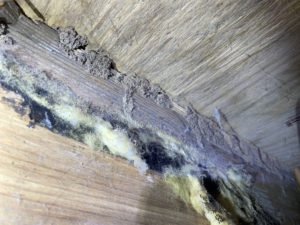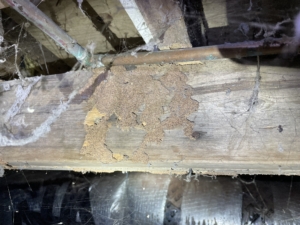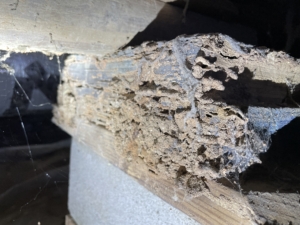Home Inspections: How to Inspect for Termites
Termites, those tiny, silent destroyers, can wreak havoc on your home if left unchecked. Often, they infest a property long before any visible signs emerge, making prevention and early detection crucial. In this blog post, we’ll provide a simple guide on how the average homeowner can inspect their home for termites, empowering you to safeguard your home against these pesky invaders.
Before diving into inspection techniques, it’s essential to understand your adversary. Termites are social insects that thrive in dark, humid environments. They feast on cellulose-based materials, such as wood and paper, making your home a prime target. There are three main types of termites: subterranean, drywood, and dampwood, each with distinct behaviors and habitats.
Prepare for your inspection by getting a flashlight and screwdriver. If your house is on a crawl space, kneepads will make the crawl space inspection much easier.
Start by examining the exterior of your home. Walk around the perimeter, closely inspecting the foundation, siding, and wooden structures. Look for mud tubes, which termites construct to travel between their nest and food source. Check for any signs of wood damage, such as hollowed-out or sagging wood, as these could indicate termite activity. Focus your attention on the foundation of your home, as this is a common entry point for termites. Look for cracks or gaps in the foundation where termites could enter. Pay close attention to areas where soil meets wood, as these are prime spots for termite infestation. Use a screwdriver to probe any suspicious areas for signs of termite damage.
Once you’ve completed the exterior inspection, it’s time to move indoors. Begin in the basement or crawlspace, as these areas are often susceptible to termite infestation. Inspect wooden beams, joists, and support posts for signs of damage or mud tubes. Check for any moisture issues, as termites thrive in damp environments. As a certified and licensed home inspector for Smith & Smith Home Inspections of Murfreesboro, TN, the most common places that I find termite damage is under the front and back exterior doors, and where the HVAC system enters the crawl space. Another popular entry point for wood destroying organisms is where the garage slab meets the house.




Next, proceed to the attic, if applicable, and inspect wooden rafters, beams, and insulation for signs of termite activity. Look for frass, which is termite droppings that resemble sawdust or coffee grounds.
Inspecting your house for termites is a crucial step in protecting your investment and ensuring the longevity of your home. A trained expert can identify subtle signs of termite activity that may elude the untrained eye. When Smith & Smith Home Inspections inspects a house that you are considering buying or selling, I’ll inspect every square foot of your home. With over a 1,000 homes inspected, my experience guides me to where termite presence and damage are commonly found. When needing a termite letter, a local exterminator can provide the service for around $50 dollars. At Smith & Smith Home Inspections, I provide due diligence in finding every defect visible. We provide home buyer inspections and home seller inspections throughout Murfreesboro, Smyrna, Lebanon, Shelbyville, Manchester, McMinnville, La Vergne, Winchester, Woodbury, Columbia, Nashville & The Greater Middle Tennessee Area. Contact us today to schedule your inspection!




Leave a Reply
Want to join the discussion?Feel free to contribute!